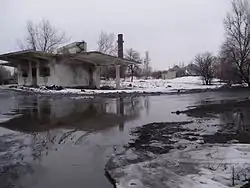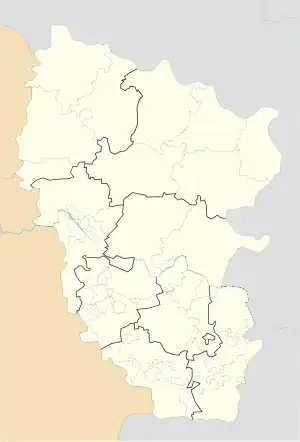Chervonopartyzansk
Chervonopartyzansk (Ukrainian: Червонопартизанськ, Russian: Червонопартизанск) is a city in Sverdlovsk Municipality, Luhansk Oblast, Ukraine. Population: 15,218 (2022 estimate).[1]
Voznesenivka
Червонопартизанськ (in Ukrainian) | |
|---|---|
 | |
 Flag  Coat of arms | |
 Voznesenivka  Voznesenivka | |
| Coordinates: 48.0833°N 39.7833°E | |
| Country | |
| Oblast | Luhansk Oblast |
| Population (2022) | |
| • Total | 15,218 |
| Area code | (+380) |
| Vehicle registration | BB / 13 |
| Climate | Dfb |
Geography
The city is located in southeastern Luhansk Oblast in the middle of the main Donets drainage divide that separates the watershed of Velyka Kamianka to the north from watersheds of Kundryucha and Burhusta rivers to the south.
Transport
To the north the city is passed by Debaltseve–Zverevo railway line. Train station Krasna Mohyla is located within the city limits
History
In the 1930s, large deposits of anthracite were discovered in the area. The first mine #63 was built during the World War II (1944) and in 1947 Chervonyi Partyzan Coal Mine was founded. Its projected capacity was 2.5 thousands tonnes of fossil fuel per day.
In 1949-1955 next to Chervonyi Partyzan, Provallya #1 and Provallya #2 were built. In 1956 these mines yielded 2.3 thousand tonnes of anthracite for Sverdlovskvuhillya Corporation.
In September 1956 Voznesenivka, Novomykolaivka, Krasna Mohyla train station, and a residential neighborhood of the Chervonyi Partyzan Mine united into the urban-type settlement of Chervonopartyzansk. In 1956 more mines were built.
A Komsomol campaign brought more than 2,000 young people from Odesa and Chernivtsi Oblasts and Moldavia to build five mines on the northern slope of Burhustyn gulch.
In 2014, Chervonopartyzansk was taken over by the rogue Luhansk People's Republic.[2] In July 2014, the city was the scene of fighting during the war in Donbas.[3]
In 2016 the city was renamed Voznesenivka (Ukrainian: Вознесенівка) due to decommunization.
References
- Чисельність наявного населення України на 1 січня 2022 [Number of Present Population of Ukraine, as of January 1, 2022] (PDF) (in Ukrainian and English). Kyiv: State Statistics Service of Ukraine. Archived (PDF) from the original on 4 July 2022.
- Численность населения по состоянию на 1 октября 2015 года по Луганской Народной Республике (PDF) (in Russian). Luhansk People's Republic. Archived from the original (PDF) on 4 February 2016. Retrieved 21 December 2015.
- Four miners killed, 16 injured after artillery shell hits bus in Chervonopartyzansk - DTEK, Interfax-Ukraine (11 July 2014)